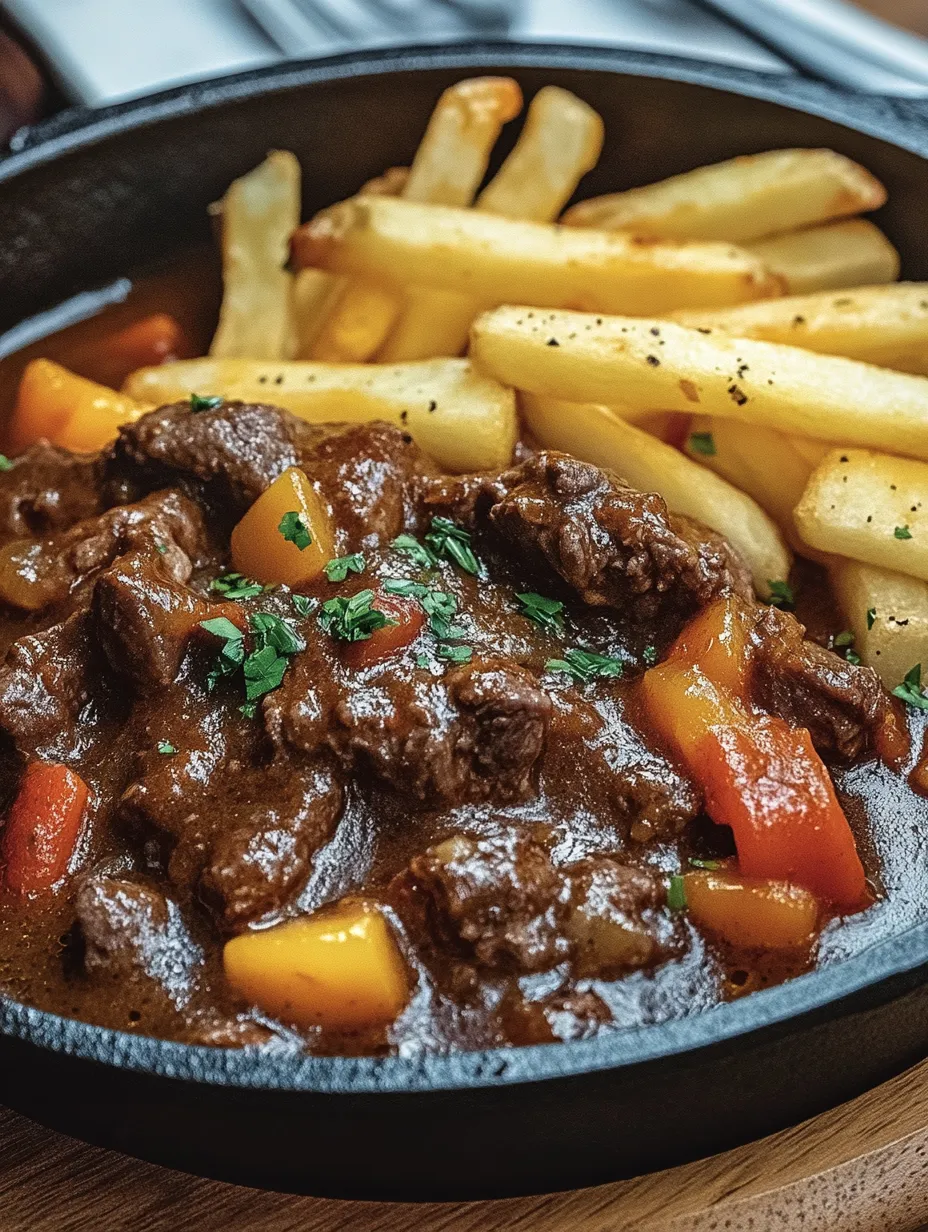 Pinnen
Pinnen
This hearty stew transforms traditional skewered schaschlik into a comforting one-pot meal that delivers all the beloved flavors in spoon-ready form. The tender chunks of pork slowly simmer with colorful vegetables in a rich tomato sauce, allowing the flavors to meld beautifully and the meat to become exceptionally tender. This rustic dish brings warmth and satisfaction to your table with minimal effort but maximum impact.
I first made this stew on a chilly autumn evening when we were craving something hearty but didn't want to fire up the grill for traditional schaschlik. The aroma that filled our home as it simmered was absolutely intoxicating. My husband, who typically prefers grilled meats, went back for seconds and declared it might be better than the original skewered version.
Quality Ingredients
- Pork shoulder: provides rich flavor and becomes wonderfully tender when slow-cooked
- Onions: create a sweet foundation and melt into the sauce as they cook
- Bell peppers: add vibrant color and subtle sweetness to balance the savory elements
- Canned tomatoes: offer convenient, consistent quality and break down to form the sauce
- Tomato paste: intensifies the tomato flavor and helps thicken the stew
- Paprika powder: contributes authentic schaschlik flavor and beautiful color
- Sugar: balances acidity from the tomatoes for perfect flavor harmony
- Salt: enhances all other flavors and properly seasons the meat
- Black pepper: adds subtle warmth and complexity
- Cooking oil: helps brown the meat for enhanced flavor development
- Rich broth: forms the liquid base that tenderizes the meat and vegetables
- Mushrooms: add earthy notes and meaty texture to the finished dish
Cooking Method
- Meat Preparation:
- Begin by trimming the pork shoulder of excess fat, leaving just enough to contribute flavor and juiciness to the finished dish. Cut the meat into uniform cubes approximately one and a half inches across to ensure even cooking. Pat the meat dry with paper towels to promote better browning. Heat a tablespoon of oil in a large Dutch oven or heavy-bottomed pot over medium-high heat until it shimmers. Working in batches to avoid overcrowding, add the meat cubes to the hot oil, allowing space between each piece. Sear the meat on all sides until it develops a rich golden-brown crust, about two minutes per side. This careful browning creates a flavor foundation for the entire dish through the Maillard reaction. Transfer the browned meat to a plate and set aside while continuing with remaining batches.
- Vegetable Foundation:
- Once all meat is browned and removed from the pot, reduce the heat to medium. If needed, add a small additional drizzle of oil to the pot. Add the diced onions to the pot, stirring to scrape up any flavorful browned bits from the bottom. Cook the onions for approximately four minutes until they become translucent and slightly golden around the edges. Add the diced bell peppers and continue cooking for another three minutes until they begin to soften but still maintain some texture. If using mushrooms, add the sliced champignons now and cook for two additional minutes until they begin to release their moisture. The vegetables should take on some color but remain relatively firm as they will continue cooking in the liquid.
- Flavor Development:
- Sprinkle the paprika powder evenly over the vegetable mixture and stir continuously for thirty seconds to toast the spice without burning it. This brief toasting intensifies the paprika's flavor and aroma. Add the tomato paste and stir continuously for one minute, allowing it to caramelize slightly which reduces any raw flavor and deepens the overall tomato profile. Sprinkle in the sugar, salt, and black pepper, stirring to incorporate everything thoroughly. The pot will appear quite dry at this point with the vegetables coated in a thick spice mixture, which concentrates flavors before the liquid is added.
- Liquid Integration:
- Return the browned meat and any accumulated juices to the pot, stirring to combine with the vegetable mixture. Add the canned tomatoes, using a wooden spoon to break them into smaller pieces if they are whole. Pour in the broth, stirring gently to incorporate all ingredients while being careful not to break up the meat pieces too much. Bring the mixture to a gentle boil, then immediately reduce the heat to maintain a very gentle simmer. The surface should show only occasional small bubbles. Cover the pot with a lid, leaving it slightly ajar to allow some steam to escape and the sauce to reduce and thicken naturally.
- Slow Simmer:
- Allow the stew to simmer gently for 30-45 minutes, checking occasionally and stirring gently to prevent any sticking at the bottom of the pot. The exact cooking time will depend on the size of your meat cubes and your desired tenderness. Test the meat at 30 minutes by piercing a larger piece with a fork; it should yield easily when properly tender. If not, continue cooking and testing every 10 minutes. As the stew cooks, the sauce will gradually thicken and the flavors will meld together beautifully. If the sauce reduces too quickly, you can add a small amount of additional broth or water to maintain the desired consistency.
I learned this version of schaschlik from my neighbor whose family came from Russia. She explained that while traditional schaschlik is grilled on skewers, this stovetop version became popular because it could be made year-round regardless of weather. Her secret was adding a pinch of caraway seeds which I've occasionally incorporated. The first time my children tried this dish, they named it "treasure stew" because they enjoyed discovering different vegetables and meat "treasures" in each spoonful.
Perfect Pairings
This versatile stew can be served in multiple ways to suit different occasions and preferences. For traditional enjoyment, ladle the schaschliktopf over fluffy white rice which absorbs the flavorful sauce beautifully. For a more rustic presentation, serve alongside slices of hearty rye bread or crusty sourdough perfect for dipping. When serving for guests, consider offering small bowls of sour cream, chopped fresh herbs like dill or parsley, and thinly sliced pickles as optional garnishes. During colder months, pair with a simple green salad dressed with lemon and oil to provide fresh contrast to the rich stew.
 Pinnen
Pinnen
Delicious Adaptations
This foundational recipe welcomes creative variations to suit your pantry and preferences. For a spicier version, add a teaspoon of hot paprika or a diced jalapeño pepper along with the bell peppers. Create a summer garden variation by incorporating diced zucchini and yellow squash during the last fifteen minutes of cooking. Transform the flavor profile by adding two tablespoons of sweet Hungarian apricot jam for subtle fruity notes that complement the paprika beautifully. For special occasions, enrich the stew with a quarter cup of dry red wine added after the tomato paste has been incorporated. Vegetable lovers might increase the mushroom quantity and add diced eggplant for a meatier texture in every bite.
Keeping It Fresh
This schaschlik stew improves with time, making it perfect for batch cooking and meal planning. Allow leftovers to cool completely before transferring to airtight containers for refrigeration, where they will keep beautifully for up to three days. Reheat portions gently on the stovetop over medium-low heat, adding a small splash of broth if the sauce has thickened too much during storage. For longer preservation, freeze cooled portions in freezer-safe containers for up to three months. Thaw overnight in the refrigerator before reheating as directed above. Consider freezing individual portions for convenient single meals that can be quickly reheated on busy weeknights.
My final thought on this schaschliktopf centers on how brilliantly it transforms a traditional grilled dish into something uniquely comforting and accessible. There's something magical about the way the simple ingredients come together through gentle simmering to create such depth of flavor. I find this dish represents the best aspects of home cooking, where technique and patience elevate humble ingredients into something truly special. Whether served at a family gathering or enjoyed as a weeknight comfort meal, this stew creates moments of connection around the table as people slow down to savor each spoonful. The evolution of schaschlik from skewered meat to this homestyle stew reminds us that cooking traditions are living things, adapting to our needs while maintaining their essential character.
Häufig gestellte Fragen
- → Kann ich auch anderes Fleisch für den Schaschliktopf verwenden?
- Ja, Rindfleisch oder Hähnchen funktionieren auch sehr gut. Beachte, dass die Garzeit je nach Fleischsorte variieren kann.
- → Wie kann ich den Schaschliktopf würziger machen?
- Füge einfach etwas Chilipulver, frische Chilischoten oder einen Spritzer Worcestersauce hinzu für mehr Würze und Tiefe im Geschmack.
- → Kann ich den Schaschliktopf einfrieren?
- Auf jeden Fall! Er eignet sich hervorragend zum Einfrieren und hält sich bis zu 3 Monate im Gefrierfach. Einfach auftauen und langsam wieder erhitzen.
- → Welche Beilagen passen am besten dazu?
- Klassisch wird der Schaschliktopf mit Reis serviert, aber auch Kartoffelpüree, Nudeln oder einfach ein Stück rustikales Brot passen wunderbar dazu.
- → Kann ich den Schaschliktopf im Voraus zubereiten?
- Ja, der Eintopf schmeckt am nächsten Tag sogar noch besser, wenn sich die Aromen richtig entfalten konnten. Einfach im Kühlschrank aufbewahren und vor dem Servieren wieder aufwärmen.
